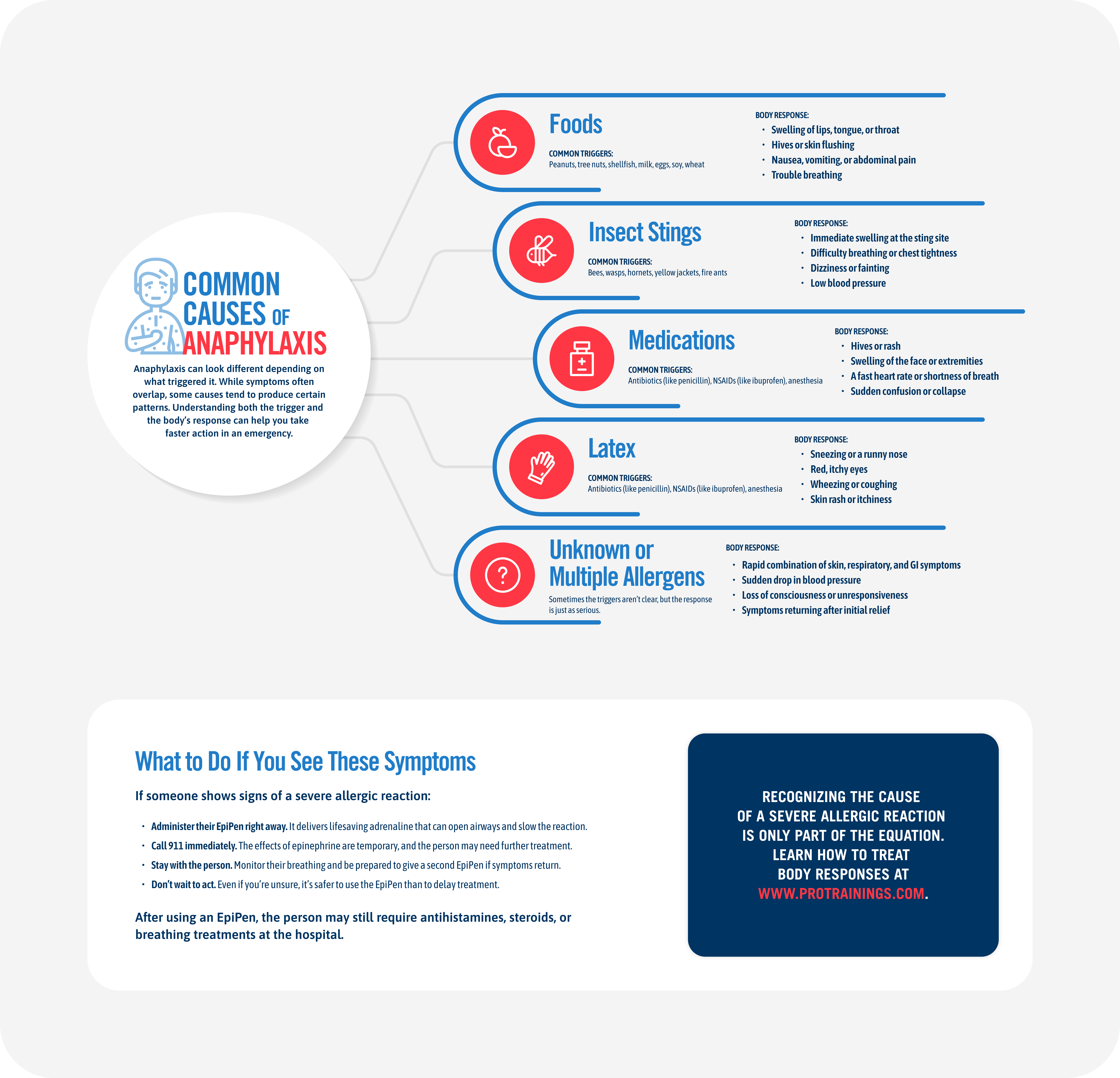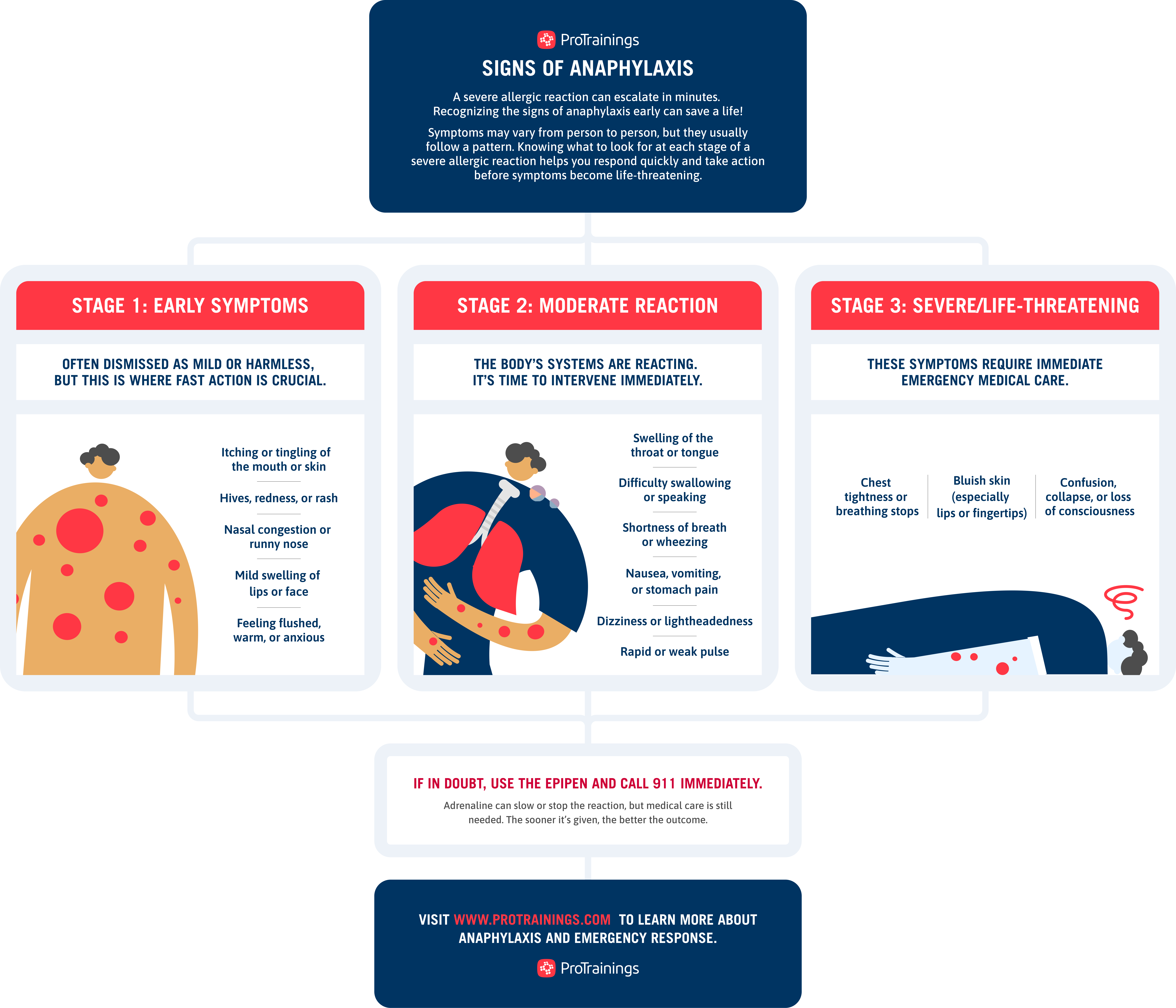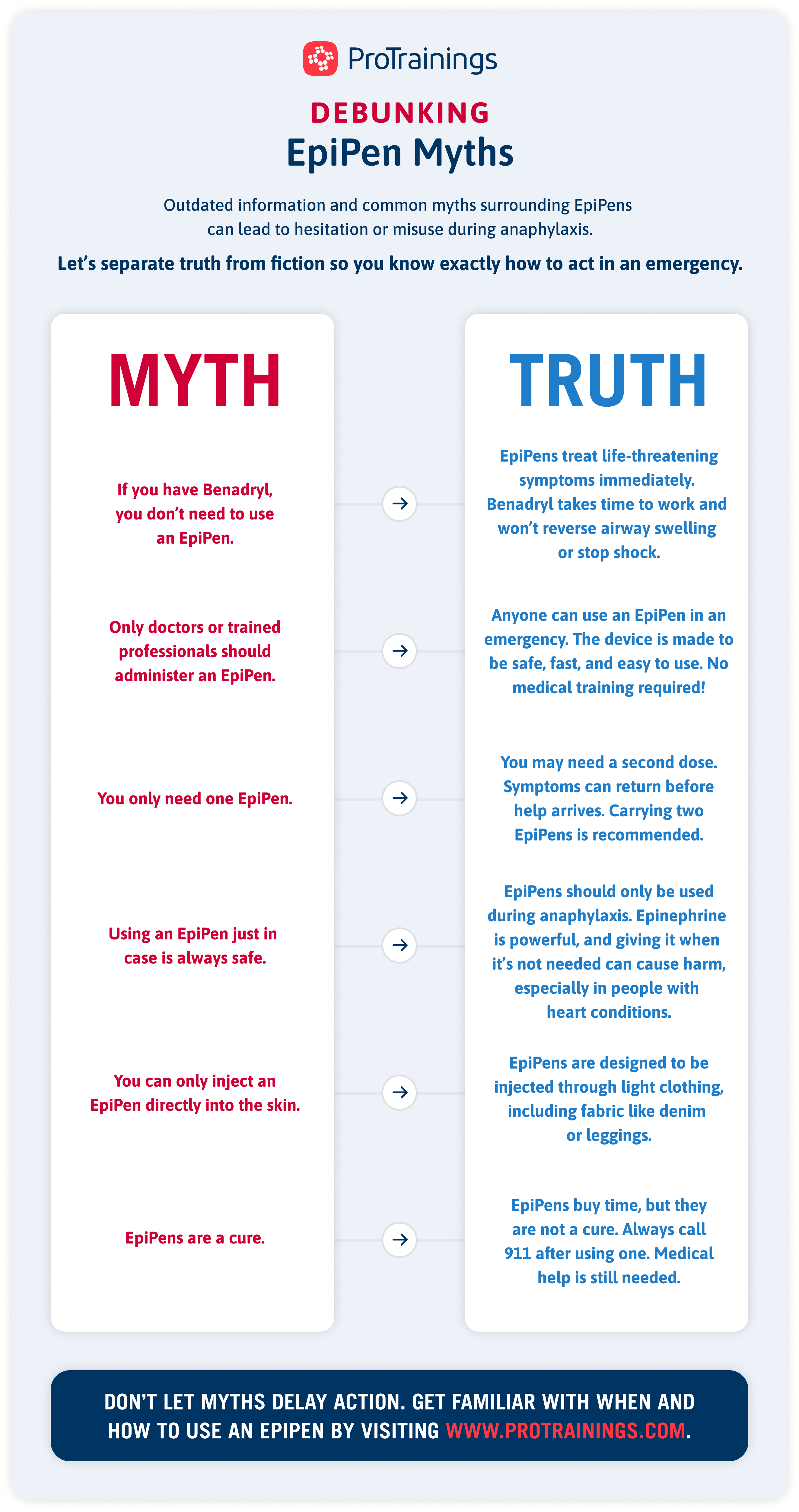Table of Contents
- What Is the History & Purpose of an EpiPen?
- How Much Does an EpiPen Cost?
- Who Should Use an EpiPen
- Who Should Not Use an EpiPen?
- How to Use an EpiPen
- How to Keep an EpiPen in Good Condition
You’re at a friend’s birthday party, enjoying the festivities, when suddenly, you hear someone gasp for air. Your friend, who has a peanut allergy, accidentally ate a treat containing peanuts. Within seconds, their throat begins to close up, and they’re struggling to breathe.
In that moment, you remember — they carry an EpiPen. You’ve seen it before, but you’ve never used one. You act quickly, knowing that getting the epinephrine into their system could be the crucial step in saving their life.
Nearly 11% of adults and 8% of children in the U.S. have food allergies, according to Allergy & Asthma Network, which means it’s possible that someone close to you has an allergy and carries an EpiPen. If an allergic reaction turns severe, you may be the one called upon to act fast.
Read on to learn how to react when anaphylaxis occurs, how to use an EpiPen, and everything else you should know about this simple, lifesaving tool.
What Is the History & Purpose of an EpiPen?
According to Healthline, the EpiPen was designed in the 1970s and was originally intended for military use. It soon found its way onto the civilian market as a treatment for a severe allergic reaction.
Designed to be user-friendly, EpiPens, or epinephrine auto-injectors, can mean the difference between life and death for those who suffer from anaphylaxis.
Anaphylaxis is caused by a severe allergic reaction and can be caused by anything from a peanut to a bee sting.
When you know how to use an EpiPen properly, this little adrenaline-filled needle has the power to reopen closed airways and give a sufferer of anaphylaxis precious minutes to seek further medical help.
How Much Does an EpiPen Cost?
In the past, the lifesaving benefits of EpiPen versus the lack of competition on the market led to pharmaceutical companies raising the price, according to Forbes.
EpiPens also have a short shelf life — just 12 months — which further increases the cost. In 2020, the average cost of a pack of two EpiPens in the U.S. for a person without medical insurance was $669.80. Doctors recommend two packs so a user always has a spare on hand.
If cost is a concern, consider generic epinephrine auto-injectors as a less expensive name-brand alternative. Be aware that while EpiPens and generic auto-injectors both use epinephrine, there may be slight differences in the design of the devices and their instructions for use.
Who Should Use an EpiPen?
An EpiPen is an essential tool for anyone at risk of a severe allergic reaction, particularly anaphylaxis, which can be life-threatening if not treated quickly. Typically, individuals who have a known severe allergy to foods, insect stings, medications, or other triggers are prescribed an EpiPen.
This includes people who’ve experienced anaphylactic reactions in the past or those diagnosed with severe allergies that pose a significant risk of an emergency situation. It’s important for both the individual carrying the EpiPen and those around them to be familiar with how to use it in case of an emergency.
In some cases, people with multiple or unpredictable allergies may also be advised to carry an EpiPen, even if they haven’t had a severe allergic reaction yet. Whether it’s an accidental exposure to peanuts, bee stings, or certain medications, being prepared with an EpiPen could be lifesaving.
Signs & Symptoms of Anaphylaxis
Recognizing the signs of anaphylaxis is the first step in determining when to use an EpiPen. Anaphylaxis can occur rapidly, sometimes within minutes of exposure to an allergen.
It affects multiple systems in the body, so symptoms can vary — from concerning to fatal — but often include:
- Difficulty breathing or shortness of breath
- Swelling of the throat or tongue, causing trouble swallowing or speaking
- Rashes, hives, or itching
- Rapid pulse or a feeling of dizziness
- Nausea, vomiting, or diarrhea
- Loss of consciousness or fainting
- Pale or bluish skin, especially around the lips or fingertips
If you or someone nearby experiences any of these symptoms after coming into contact with a known allergen, administer the EpiPen as soon as possible and seek emergency medical help immediately. The EpiPen can help slow the effects of the allergic reaction and buy valuable time until professional medical assistance arrives.

When to Use an EpiPen Versus Benadryl
While it’s important to know how to use an EpiPen, it’s also important to keep in mind that an EpiPen is used to treat severe allergic reactions. Depending on the severity of the reaction, the person may be able to administer it themselves, or they may be too encumbered by the reaction to have the capacity to do this.
Anaphylaxis is the result of an overwhelming histamine reaction by the immune system.
Antihistamines, such as cetirizine (Zyrtec), loratadine (Claritin), diphenhydramine (Benadryl), and others, may be a good option for milder allergic reactions or use after epinephrine has been given.
Unlike the epinephrine in EpiPens, antihistamines take some time to start working. They’ll help stop the symptoms from getting worse, but they don’t help in reversing the critical symptoms.
When to Use an EpiPen
Sometimes during a severe allergic reaction, a person will lose consciousness completely. If in doubt, use the EpiPen! It may preserve someone’s life for long enough to allow for medical help to arrive.
The effect of the adrenaline is temporary, and the victim will need further treatment — possibly even a second epinephrine auto-injector — so be sure to call for help after administering the EpiPen.
With further medical treatment, it’s common for the victim to be given an antihistamine, a steroid, and possibly a breathing treatment.

Who Should Not Use an EpiPen?
Knowing how to use an EpiPen doesn’t necessarily mean you should use one. In some cases, an EpiPen can do more harm than good.
Someone who isn’t suffering from anaphylaxis shouldn’t use an EpiPen.
The adrenaline increases the heart rate and can be fatal to anyone who doesn’t need it. For example, if someone has a known or unknown heart condition, an EpiPen could cause extra strain on the heart and cause severe negative results. If you have known heart conditions, be sure to talk to your doctor about specific use cases for epinephrine.
If you’ve accidentally injected an EpiPen into someone who isn’t experiencing anaphylaxis, seek emergency medical attention for them.
How to Use an EpiPen
If someone you know has a severe allergy, knowing where they keep an EpiPen as well as when and how to use it can make all the difference when you’re waiting for medical professionals to arrive.
First, keep calm. Then follow these two simple steps:
- Grasp the EpiPen in your fist with the orange tip pointing downward. Remove the blue safety cap by pulling it straight up. Do NOT put your thumb over either end of the device.
- Place the orange tip against the middle of the outer thigh. Swing and push the EpiPen firmly into the thigh until it clicks. Hold it firmly in place for three seconds.
To ensure you’re fully prepared, watching a video demonstration can be helpful. This How to Use an EpiPen video walks you through the entire process step by step, showing you exactly how to use an EpiPen in an emergency.
If you’re looking for a quicker guide, this How to Use an EpiPen video provides a short, easy-to-follow demo of the key steps, so you can see the technique in action.
You can also download our helpful infographic to keep on hand in case of an anaphylactic emergency.

There’s a common myth that you can’t use an EpiPen through clothing. This is untrue. In fact, the device is designed to be effective even if administered through light clothing, as long as the needle can penetrate the fabric and reach the thigh, where the medication is needed.
Other myths about EpiPens that can lead to confusion or hesitation during an emergency. These misconceptions can prevent people from acting quickly when someone needs help.

How to Keep an EpiPen in Good Condition
It’s essential to know how to use an EpiPen properly and also how to store it correctly to ensure maximum effectiveness when the time comes to use it. Here’s how to properly maintain an EpiPen:
- Keep an EpiPen at room temperature.
- Keep an EpiPen in its carrier tube.
- Keep the blue safety cap on the EpiPen until it’s needed for injection.
- Ensure the solution inside is always clear. You can check this through the viewing window on the side of the injector.
EpiPens can save lives when used properly. However, expired medications may lose potency or be dangerous to use. Be sure to keep your medications up to date.
Always seek further medical treatment after administering the adrenaline, and only give someone an EpiPen under the right circumstances. When you know how to use an EpiPen correctly, it offers a lifeline for people who suffer from anaphylaxis.
To learn more about epinephrine and its effects on the body, check out our Anaphylaxis & Epinephrine Auto-Injector course.
Contact us today to discuss how ProTrainings can help broaden your staff’s knowledge of CPR techniques. We can make getting your staff CPR certified easier and more efficient.
